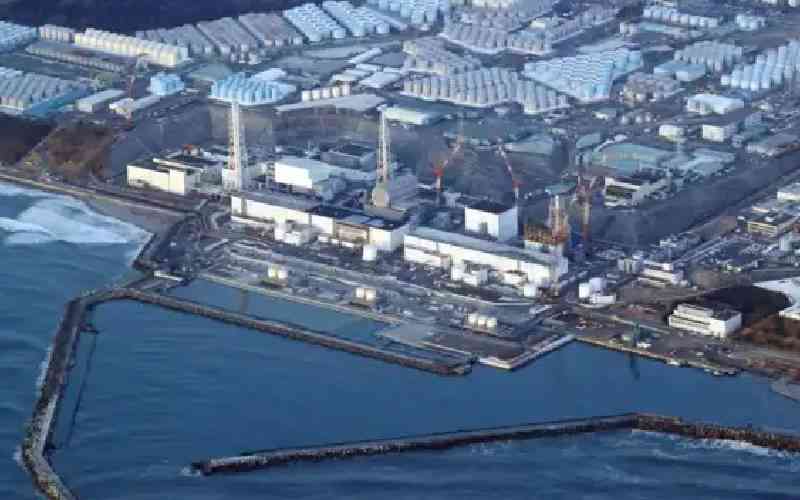
Japanese media reported Monday that the country is due to start releasing wastewater used to cool the crippled reactors at the Fukushima Daiichi nuclear plant as soon as the end of August.
The reports say Japanese Prime Minister Fumio Kishida is expected to discuss the issue at a trilateral meeting with U.S. President Joe Biden and South Korean President Yoon Suk Yeol, scheduled August 18 at Camp David, Maryland.
Washington and Seoul have offered support for Japan after the United Nations’ nuclear watchdog, the International Atomic Energy Agency, approved the plans to release the wastewater following a visit to the site July 4.
However, China has criticized the move and imposed restrictions on Japanese seafood imports.
Meltdown
Three reactors at the Fukushima Daiichi nuclear power plant went into meltdown after the March 11, 2011, earthquake and tsunami cut power to the site.
Seawater from the adjacent Pacific Ocean has been used to cool the reactors. Over one thousand giant tanks now surround the wrecked plant, holding more 1.3 million metric tons of wastewater.
The wastewater has been treated using a system called ‘ALPS’ to remove most of the radioactive contaminants. However, the water still contains the radioactive element tritium, explains American scientist Paul Dickman of the U.S. Argonne National Laboratory, who has been advising the Japanese government on the decommissioning process.
“It is natural, it's in everything we eat, drink and breathe. Anything that has water in it has tritium in it,” Dickman told VOA in an interview August 4.
“All nuclear reactors produce, as a byproduct, small amounts of tritium. And the way that you deal with this - and we have, constantly - is to discharge this either through evaporation into the air or discharge it into a water body, particularly if you're by the sea. So that is standard practice that has been going on for decades now,” he added.
Japan plans to release the water over 30 to 40 years, diluting the tritium concentration until it exceeds drinking water standards.
IAEA approval
The plan was approved by the International Atomic Energy Agency last month, after a two-year review showed the water release would have a negligible impact on the environment.
After meeting local fishing communities and environmental groups, IAEA Director General Rafael Grossi said the process would be closely monitored.
“I don't have a magic solution for the doubts and concerns that may exist, but we do have one thing - we are going to stay here with you for decades to come... until the last drop of the water has been safely discharged,” Grossi said July 6.
Reputation fears
Those assurances have not satisfied the plan’s critics. At Tokyo’s giant Tsukiji fish market, where millions of dollars of seafood are traded every day, stall holders told VOA that they fear reputational damage.
“The Japanese brand will decline. People will ask, is it being properly checked?” said Tomohisa Yoshimura, who sells dried bonito flakes, a staple of Japanese cuisine.
Matao Saito, a tuna trader, echoed those concerns. “I'm worried about how other countries see it. I think that there are harmful rumors in Japan,” he told VOA August 4.
China restrictions
The overwhelming majority of scientists say the plan is safe. But some of Japan’s neighbors, especially China, have strongly criticized the move. Beijing has imposed restrictions and extra checks on some Japanese seafood imports.
“Our opposition to Japan's ocean discharge plan and the relevant measures we are taking are well grounded,” said Mao Ning, a spokesperson for the Chinese Foreign Ministry, after being questioned by reporters July 20.
Nuclear power stations across the world – including many in China – constantly dispose of tritium into the sea, says U.S. scientist Paul Dickman.
“This was a political opportunity to basically poke (Japan) in the eye,” Dickman told VOA. “There is a point of hypocrisy here. They're accusing Japanese of doing what they do. The regulatory authorities both in Korea and China - who I think are pretty good - were quiet. They were silent on this. And yet they are authorizing their own companies and their own reactors to discharge into the sea every day. I think it was a big mistake and it undermines their authority,” Dickman said.
Beijing does not publish figures of how much it releases into the oceans.
Communications campaign
Meanwhile Japan is conducting a mass communications campaign, with advertisements on billboards and in newspapers, and animated movies on television, to convince the public that the process is safe. TEPCO, the operator of the Fukushima Daiichi plant, has even set up a live stream of fish living in a tank of treated wastewater to prove its safety.
For the residents of Fukushima, the latest political and public relations battle is yet another strain after more than twelve years of suffering. Katsumasa Okawa runs a seafood business in Fukushima prefecture.
“Countries such as China are saying they will halt the import (of seafood) if the water is released. The topic has become very diplomatic and political. I don’t know what’s happening anymore. I feel like the discussion has veered away from what really matters,” Okawa told the Associated Press.